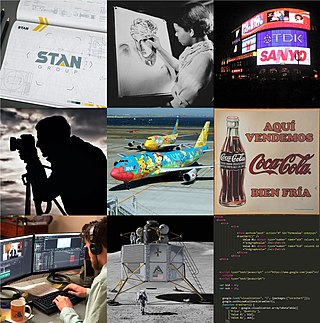
Graphic design is a profession, academic discipline and applied art whose activity consists in projecting visual communications intended to transmit specific messages to social groups, with specific objectives. Graphic design is an interdisciplinary branch of design and of the fine arts. Its practice involves creativity, innovation and lateral thinking using manual or digital tools, where it is usual to use text and graphics to communicate visually.
Multimedia is a form of communication that uses a combination of different content forms such as writing, audio, images, animations, or video into a single interactive presentation, in contrast to traditional mass media, such as printed material or audio recordings, which features little to no interaction between users. Popular examples of multimedia include video podcasts, audio slideshows and animated videos. Multimedia also contains the principles and application of effective interactive communication such as the building blocks of software, hardware, and other technologies. The five main building blocks of multimedia are text, image, audio, video, and animation.
Media literacy is an expanded conceptualization of literacy that includes the ability to access and analyze media messages as well as create, reflect and take action, using the power of information and communication to make a difference in the world. Media literacy is not restricted to one medium and is understood as a set of competencies that are essential for work, life, and citizenship. Media literacy education is the process used to advance media literacy competencies, and it is intended to promote awareness of media influence and create an active stance towards both consuming and creating media. Media literacy education is part of the curriculum in the United States and some European Union countries, and an interdisciplinary global community of media scholars and educators engages in knowledge and scholarly and professional journals and national membership associations.
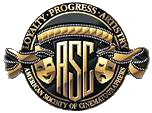
The American Society of Cinematographers (ASC), founded in Hollywood in 1919, is a cultural, educational, and professional organization that is neither a labor union nor a guild. The society was organized to advance the science and art of cinematography and gather a wide range of cinematographers to discuss techniques and ideas and to advocate for motion pictures as a type of art form. Currently, the president of the ASC is Shelly Johnson.

Visual communication is the use of visual elements to convey ideas and information which include signs, typography, drawing, graphic design, illustration, industrial design, advertising, animation, and electronic resources. Visual communication has been proven to be unique when compared to other verbal or written languages because of its more abstract structure. It stands out for its uniqueness, as the interpretation of signs varies on the viewer's field of experience. The interpretation of imagery is often compared to the set alphabets and words used in oral or written languages. Another point of difference found by scholars is that, though written or verbal languages are taught, sight does not have to be learned and therefore people of sight may lack awareness of visual communication and its influence in their everyday life. Many of the visual elements listed above are forms of visual communication that humans have been using since prehistoric times. Within modern culture, there are several types of characteristics when it comes to visual elements, they consist of objects, models, graphs, diagrams, maps, and photographs. Outside the different types of characteristics and elements, there are seven components of visual communication: color, shape, tones, texture, figure-ground, balance, and hierarchy.
Learning styles refer to a range of theories that aim to account for differences in individuals' learning. Although there is ample evidence that individuals express personal preferences for how they prefer to receive information, few studies have found any validity in using learning styles in education. Many theories share the proposition that humans can be classified according to their "style" of learning, but differ in how the proposed styles should be defined, categorized and assessed. A common concept is that individuals differ in how they learn.

Visual arts education is the area of learning that is based upon the kind of art that one can see, visual arts—drawing, painting, sculpture, printmaking, and design in jewelry, pottery, weaving, fabrics, etc. and design applied to more practical fields such as commercial graphics and home furnishings. Contemporary topics include photography, video, film, design, and computer art. Art education may focus on students creating art, on learning to criticize or appreciate art, or some combination of the two.
Physics education or physics teaching refers to the education methods currently used to teach physics. The occupation is called physics educator or physics teacher. Physics education research refers to an area of pedagogical research that seeks to improve those methods. Historically, physics has been taught at the high school and college level primarily by the lecture method together with laboratory exercises aimed at verifying concepts taught in the lectures. These concepts are better understood when lectures are accompanied with demonstration, hand-on experiments, and questions that require students to ponder what will happen in an experiment and why. Students who participate in active learning for example with hands-on experiments learn through self-discovery. By trial and error they learn to change their preconceptions about phenomena in physics and discover the underlying concepts. Physics education is part of the broader area of science education.
Audiovisual education or multimedia-based education (MBE) is an instruction where particular attention is paid to the audiovisual or multimedia presentation of the material with the goal of improving comprehension and retention.

Inclusion in education refers to all students being able to access and gain equal opportunities to education and learning. It arose in the context of special education with an individualized education program or 504 plan, and is built on the notion that it is more effective for students with special needs to have the said mixed experience for them to be more successful in social interactions leading to further success in life. The philosophy behind the implementation of the inclusion model does not prioritize, but still provides for the utilization of special classrooms and special schools for the education of students with disabilities. Inclusive education models are brought into force by educational administrators with the intention of moving away from seclusion models of special education to the fullest extent practical, the idea being that it is to the social benefit of general education students and special education students alike, with the more able students serving as peer models and those less able serving as motivation for general education students to learn empathy.

A school library is a library within a school where students, staff, and often, parents of a public or private school have access to a variety of resources. The goal of the school library media center is to ensure that all members of the school community have equitable access "to books and reading, to information, and to information technology." A school library media center "uses all types of media... is automated, and utilizes the Internet [as well as books] for information gathering." School libraries are distinct from public libraries because they serve as "learner-oriented laboratories which support, extend, and individualize the school's curriculum... A school library serves as the center and coordinating agency for all material used in the school."
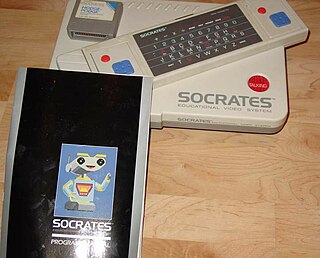
An educational video game is a video game that provides learning or training value to the player. Edutainment describes an intentional merger of video games and educational software into a single product. In the narrower sense used here, the term describes educational software which is primarily about entertainment, but tends to educate as well and sells itself partly under the educational umbrella. Normally software of this kind is not structured towards school curricula and does not involve educational advisors.
Christina Castillo Comer is the former Director of Science in the curriculum division of the Texas Education Agency (TEA). Comer spent nine years as the Director of Science until she resigned on November 7, 2007. Comer's resignation has sparked controversy about agency politics and the debate to teach evolution in public schools versus creationism or intelligent design.
The use of comics in education is based on the concept of creating engagement and motivation for students.

A film – also called a movie, motion picture, moving picture, picture, photoplay or (slang) flick – is a work of visual art that simulates experiences and otherwise communicates ideas, stories, perceptions, feelings, beauty, or atmosphere through the use of moving images. These images are generally accompanied by sound and, more rarely, other sensory stimulations. The word "cinema", short for cinematography, is often used to refer to filmmaking and the film industry, and the art form that is the result of it.
Augmented learning is an on-demand learning technique where the environment adapts to the learner. By providing remediation on-demand, learners can gain greater understanding of a topic while stimulating discovery and learning. Technologies incorporating rich media and interaction have demonstrated the educational potential that scholars, teachers and students are embracing. Instead of focusing on memorization, the learner experiences an adaptive learning experience based upon the current context. The augmented content can be dynamically tailored to the learner's natural environment by displaying text, images, video or even playing audio. This additional information is commonly shown in a pop-up window for computer-based environments.
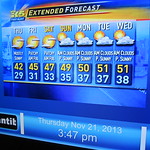
Multimodality is the application of multiple literacies within one medium. Multiple literacies or "modes" contribute to an audience's understanding of a composition. Everything from the placement of images to the organization of the content to the method of delivery creates meaning. This is the result of a shift from isolated text being relied on as the primary source of communication, to the image being utilized more frequently in the digital age. Multimodality describes communication practices in terms of the textual, aural, linguistic, spatial, and visual resources used to compose messages.
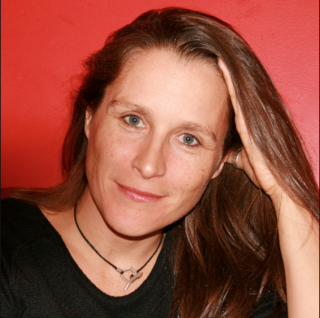
Catherine Gund is an American producer, director, and writer who founded Aubin Pictures in 1996.
Dawson Elementary School is an elementary school in the Austin Independent School District (AISD) currently serving students in pre-kindergarten through fifth grade. The school is located at 3001 South First Street in South Austin, Texas, and is named after Mary Jane "Mollie" Dawson, a beloved teacher and school administrator who worked in Austin in the late nineteenth century.

Laura Thornburgh was an American author, journalist, photographer, director, and film editor who was best known for her 1937 guidebook to Great Smoky Mountains National Park, published under the pen name Laura Thornborough. Her landmark publication Motion Pictures in Education popularized the usage of audiovisual aids in the classroom. As part of the war effort, Thornburgh joined the United States Department of Agriculture film department under the supervision of Don Carlos Ellis as a scenario editor, making her the first film editor for the United States Government.












